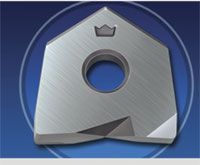supplier: Millstar
end user: AarKel Tool and Die
AarKel Tool and Die Inc. knows its geometry. The Wallaceburg, ON, maker of die cast dies and plastic injection moulds for the automotive sector has been using a crossover, combination geometry insert from Millstar for about 15 years now, says Brandon Doom, machining manager at Plant 2.
Like any shop, AarKel uses different inserts for different kinds of work. But Doom says that when it comes to applications that would normally go through a lot of inserts, the shop relies on the Millstar BDS hybrid two-flute bull nose insert, purchased from Millstar distributor Industrial Tools and Supplies (Windsor) Inc. AarKel uses the insert on its Kuraki and Juaristi boring mills and its FPT Pragma and Emco Mecof horizontal mills.
The inserts enable operators to remove more material in a single pass, Doom says. “When we’re refinishing we can probably triple our stepdown due to the geometry of the insert. That’s three times quicker—and we don’t have to slow down.”
AarKel does a lot of steep wall milling, and that increased depth of cut is especially helpful on those jobs.
“We’d typically take a 30/1000 in. step down with a cutter,” Doom says. “Because the BDS has a straight edge on the side that’s probably about an eighth of an inch, that allows us to take a 100/1000 in. step down. And we get a really good finish with it.”
The “hybrid” in the insert’s name refers to the fact that the insert’s crossover design combines flat bottom geometry with back draft geometry. The flat bottom means more efficient cutting in restricted spaces. “If you’re going into areas that have a lot of material on the bottom and not on the side, it allows you to cut a smaller diameter without having to clear the diameter of the cutter,” Doom says. The back draft clears the material away so there’s no rubbing and a pocket can be finished more accurately.
 Cost is also a major reason AarKel has stuck with the insert for so long. AarKel could spend more to get inserts with a longer lifecycle, but because the BDS yields improved productivity, the cost analysis shows that it’s the more economical choice. Doom says the BDS inserts cost about two thirds what comparable inserts would, and because they deliver more throughput there’s a time savings that has to be factored in.
Cost is also a major reason AarKel has stuck with the insert for so long. AarKel could spend more to get inserts with a longer lifecycle, but because the BDS yields improved productivity, the cost analysis shows that it’s the more economical choice. Doom says the BDS inserts cost about two thirds what comparable inserts would, and because they deliver more throughput there’s a time savings that has to be factored in.
“The customer wants things quicker and quicker every day,” Doom says. “It’s the nature of the business—they want to get it for less and they want you to do it quicker.” SMT
